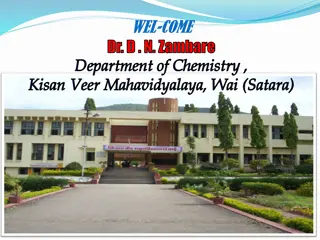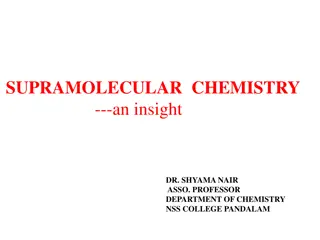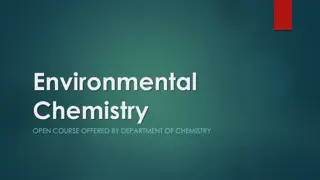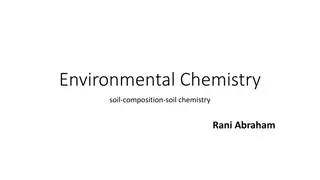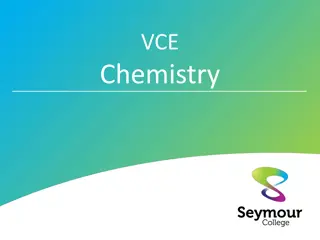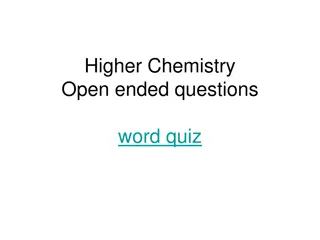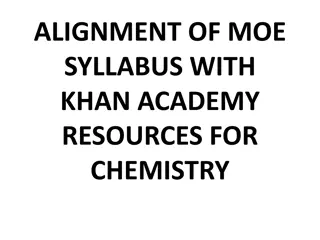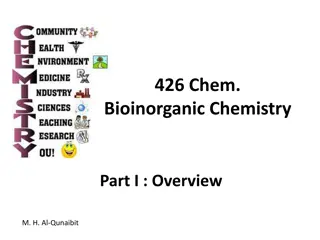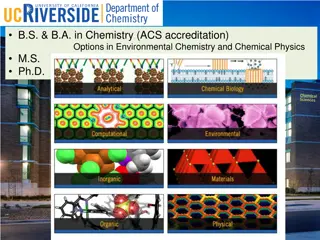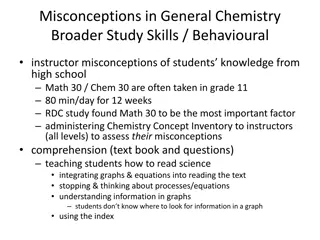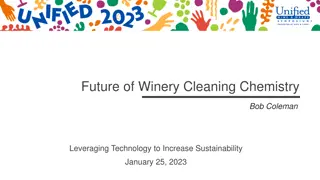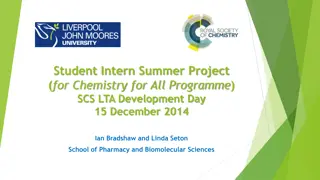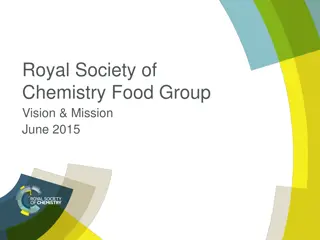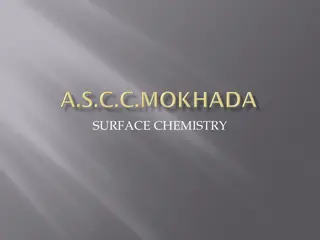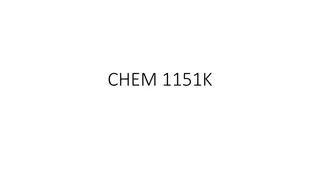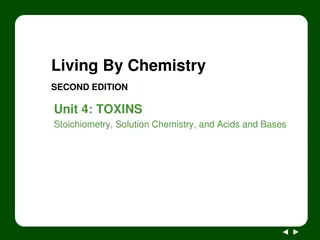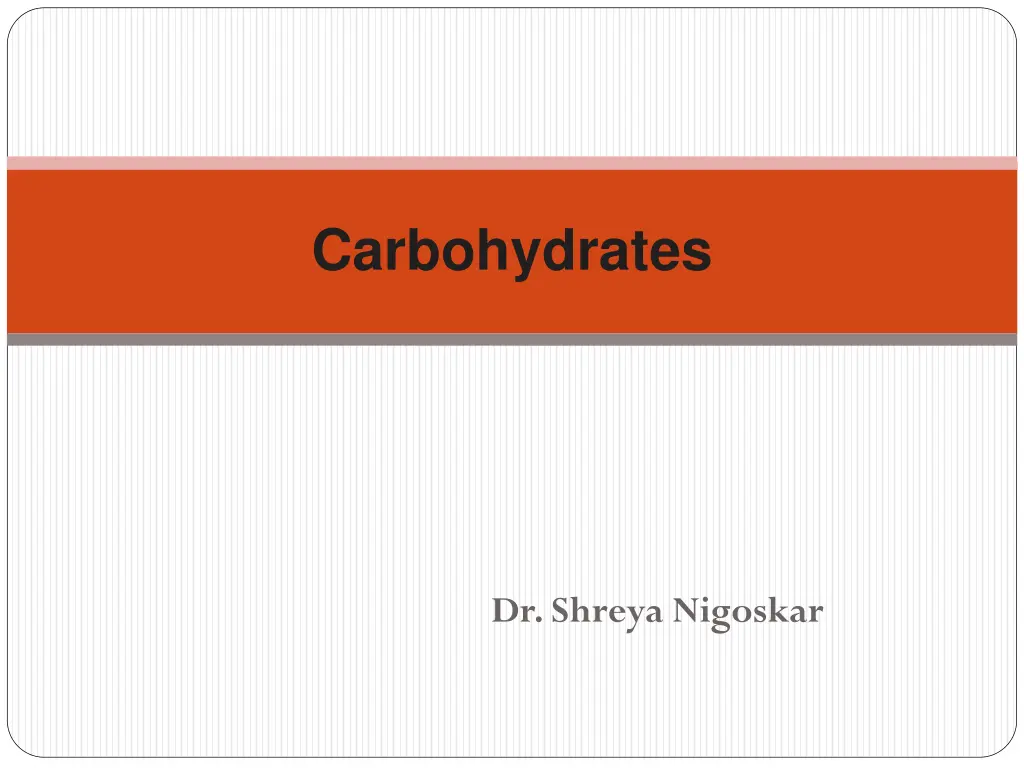
Understanding Carbohydrates: Functions, Classification, and Properties
Explore the world of carbohydrates with Dr. Shreya Nigoskar, as you learn about their importance in providing energy, their biomedical significance, and their classification into monosaccharides, oligosaccharides, and polysaccharides. Discover the general properties of monosaccharides and delve into the diverse roles of carbohydrates in living organisms.
Uploaded on | 0 Views
Download Presentation

Please find below an Image/Link to download the presentation.
The content on the website is provided AS IS for your information and personal use only. It may not be sold, licensed, or shared on other websites without obtaining consent from the author. If you encounter any issues during the download, it is possible that the publisher has removed the file from their server.
You are allowed to download the files provided on this website for personal or commercial use, subject to the condition that they are used lawfully. All files are the property of their respective owners.
The content on the website is provided AS IS for your information and personal use only. It may not be sold, licensed, or shared on other websites without obtaining consent from the author.
E N D
Presentation Transcript
Carbohydrates Dr. Shreya Nigoskar
INTRODUCTION Carbon + Hydrogen + Oxygen Found in abundance in plant kingdom in the form of cellulose and starch besides this also found in animal kingdom in the form of glucose and glycogen. Carbohydrate Carbohydrates are neutral compounds made up of carbon, hydrogen and oxygen. H and O being in the same proportion as in water, the general formula is Cn(H2O)n. But there are many exceptions, e.g. rhaminose (C6H12O5) is a carbohydrate in which H and O are present in different proportion. Certain other compounds such as formaldehyde (HCHO) acetic acid (CH3COOH), lactic acid (CH3CHOCOOH) etc. which have got the same empirical formula but are not carbohydrates. Thus, chemically carbohydrates can be defined as the aldehyde and ketone derivative of higher polyhydric alcohol or polyhydroxy aldehydes or ketones or the compounds which produce them on hydrolysis.
Biomedical Importance 1.Carbohydrates are the main source of energy. 2.They are constituents of compound lipids and conjugated proteins. 3.Degradation products of carbohydrates act as promoters or catalyst. 4.Certain carbohydrate derivatives are used as drugs like cardiac glycosides / antibiotics. 5.Degradation products are utilized for synthesis of other substances such as fatty acid, cholesterol, amino acids, etc. 6.They are the constituents of mucopolysaccharides and form the ground substance of mesenchymal tissues. 7.Ribose is a constituent of nucleic acid (DNA, RNA). 8.Ribose, i.e. pentose sugar also constituents certain coenzyme, e.g. FAD, NAD, coenzyme A, etc. 9.Glucose is chief physiological sugar present in blood, i.e. about 0.1%.
Classification Classification Carbohydrates are classified into three classes I.Monosaccharides II.Oligosaccharides III.Polysaccharides
Monosaccharides Simplestclassofcarbohydrateswhichcannotbefurtherhydrolysed.Thesearefurtherclassified intotwogroups.Onthe basisoftheirfunctionalgrouptheyareclassifiedasoldosesandAldoses a. Aldoses When the functional group is an aldehyde CH-O in a monosaccharide. b. Ketoses In ketoses the functional group is a keto group C=O. The number of carbon atoms in the monosaccharides are given in the Table 1.1. Sr. No. Monosaccharide No. of carbon atoms Aldoses Ketoses 1. Triose 3 Glyceraldehyde Dehydroxy acetone p Erythrulose 2. Tetrose 4 Erythrose 3 Pentose 5 Ribose Ribulose 4 Hexoses 6 Glucose Fructose 5 Heptoses 7 Glucoheptose Sedoheptulose
General Properties of Monosaccharides 1.Colourless, crystalline compound, having sweet taste, soluble in water, insolublein benzene and ether, sparingly soluble in alcohol. 2.Optical rotation When a beam of polarised light is passed through a solution containing assymetric carbon compound then this light is rotated clockwise or to right side to be dextrorotatory represented by d or (+) and is rotated anticlockwise or left then said to be levoratory represented by l or ( ). The mixture containing d l isomers in equal proportion is called as recemic mixture. It does not exhibit any optical activity since both d and l activities cancel each other. Freshly made solution of glucose has specific rotation of 112 . When solution is made to stand the value falls and after 24 hours and stabilizes to 52.5 . The initial optical rotation shown by sugar gradually changes until a fixed rotation characteristic of sugar is reached. 3.Sugars exist both in straight chain form and ring form. Six membered rings are called as pyranose.Five membered rings are called as furanose.
MUTAROTATION Mutarotation Mutarotation is defined as the change in optical rotation representing the interconversion of and forms of D glucose to an equilibrium mixture (Fig. 1.2). D Glucose + 112.2 *(Specific optical rotation). D Glucose + 18.7 Equilliberim mixture + 52.7 <==== => <==== => Mutarotation of fructose Fructose also exhibits mutarotation. It has a specific optical rotation equilibrium. The conversionof dextroratatorysucroseto levoratatoryfructosecan be explained in inversion. of -92 at Epimers If two monosaccharides differ from each other in their configuration around a single specific carbon (other than anomeric) atom, they are referred to as epimers to each other. For example glucose and galactose are epimers (C4epimers), glucose and mannose are (C2epimers). Fig. 1.3: Structures of epimers (glucose and galactose are C4epimers while glucose and mannose are C2 epimers )
Anomers The and forms of D glucose are known as anomers, they differ from each other in the configuration only around C1 known as anomeric carbon (hemiacetal carbon). In case of anomer, the OH group held by anomeric carbon is on the opposite side of the group CH2OH of sugar ring and vice versa with the anomer (Fig. 1.2). Tautomerization or Enolization When a hydrogen atom is shifted from one carbon atom to another to produce enediols is known as tautomerization. When glucose is kept in alkaline solution, it forms isomers D fructose and D mannose which results in the formation of a common intermediate enediol for all the three sugar. Enediols are highly reactive, hence sugars in alkaline solution are powerful reducing agents. Reducing Properties The sugars are classified as reducing or nonreducing. The reducing property is attributed to the free aldehyde or keto group of anomeric carbon. In lab many tests are employed to identify the reducing action of sugars. These include Benedict s test, Fehlings test. The reduction is much more efficient in alkaline medium . The enediols or sugars reduce CuSO4 (Cu++) to (Cu+) cuprous ions which form (green < > yellow) ppt of cuprous hydroxide or (orange< >red) ppt of cuprous oxide depending upon concentrations of sugar. This property cannot help for specific identification of any sugar. Since, it is general reaction.
Osazone Formation It is the reaction with hydrazine to form hydrazones which are called as osazones. Glucose + H2N-NH-C6H5 - Phenyl glucose hydrazone. These osazones are insoluble and crystallize in beautiful and characterstic form of different sugars. As it is evident from the reaction, the first two carbon (C1 and C2) are involved in osazone formation. The sugars that differ in their configuration on these two carbons give the same types of osazomes, since the difference is marked by reaction with phenyl hydrazine. Thus, glucose, fructose and mannose give same type of osazone crystal. Glucose, fructose and mannose have identical osazone crystals arranged as bundle of hay. (Broom stick) needle like Lactose forms cotton wool like crystals puffy ball like crystals. Maltose and galactose form sunflower platelet like structure. THE PICTURES CAN BE SEEN IN PART II PRACTICALS
Glycosides Glycosides are formed when the hemiacetal or hemiketal hydroxyl group (of anomeric carbon) of a carbohydrate reacts with a hydroxyl group of another carbohydrate. The bond so formed is known as glycosidic bond. The monosaccharides are held together by glycosidic bonds to result in di-, oligo- or polysaccharides. It should be noted that the reducing property of aldehyde and keto group is lost, when these groups participate in glycosidic bond formation. However, many di-and polysaccharides are reducing due to presence of other potential aldehyde or keto groups. Naming of Glycosidic Bond The nomenclature of glycosidic bonds is based on the linkages between carbon atoms and the status of the anomeric carbon ( or ). For instance, lactose which is formed by a bond between C1 of galactose and C4 of glucose is named as (1 4) glycosidic bond. Dehydration When monosaccharides are treated with concentrated acids, for example sulphuric acid, hydrochloric acid, etc. there occurs dehydration, thus pentoses give furfurals, and hecoses give hydroxy methyl furfurel. These furfurals can condense with phenolic compounds like nepthol. This is the chemical base for Molisch test, which is a group test for carbohydrates. Selivanoff s Test This test is specific for fructose. Resorcinol dissolved in conc HCl is added to sugar then pink colour is formed due to reaction of furfural with reasorinol.
II Oligosachharides These type of carbohydrates are composed of 2-10 monosachharide molecules which can be obtained on hydrolysis. The important oligosaccharides are classified as (shown in Table 1.2): Disaccharides Trisaccharides Tetrasaccharides Pentasaccharides. Depending on number of monosaccharide oligosaccharides disaccharides are most common. As the name suggests, a disaccharide unit consists of two monosaccharide units (similar or dis similar) which are held together by glycoside bond. Diasaccharides are of two types 1.Reducing. 2.Non-reducing. Disaccharide units produce two molecules of monosaccharide units on hydrolysis. The most common disaccharides are Lactose Glucose + Galactose [ 1 4 ] Glycosidic bond Maltose Glucose + Glucose [ 1 4 ] Glycosidic bond Sucrose Glucose + Fructose [ 1 - 2] Glycosidic bond units. Among the
Sr. No. Oligosaccharide No. of carbon atoms Types Di 2 Lactose sucrose maltose Raffinose 1. 2. 3 4 Tri 3 Tetra 4 Stachyose Penta 5 Verbascose Sucrose Surcose is sugar of commerce. Its source is cane sugar. It is dextrorotatory. Hydrolysis of it by dilute acid or enzyme invertase or sucrase produce 1 molecule each of glucose and fructose which results in change in optical rotation from positive to negative because fructose is more levorotatory than D glucose. Sucrase Sucrose + H2O Glucose + Fructose Because of this sucrose is called as invert sugar. Honey contains a large proportion of sucrose. Sucrose is not a reducing sugar because the reducing groups of glucose and fructose are involved in glycosidic bond formation. So, it can not form osazones. Lactose Lactose is formed by mammary glands and occurs to the extent of about 5% in milk. Therefore, it is most commonly known as milk sugar. Lactose of milk is the most important carbohydrate in the nutrition of young mammals. It is hydrolsed by enzyme lactase in to glucose and galactose. It may also be present in the urine during pregnancy. It is a reducing sugar. Souring of milk take placewhen lactoseisconverted tolactic acid.Itgivesosazonecrystals [cotton woolshaped].
Maltose Maltose is also called as malt sugar. Maltose is composed of two glucose units and is formed by hydrolytic action of enzyme amylase or diastase on starch It is a reducing sugar. In it the glucose units are held together by (1 4) linkage. It gives osazone crystals [sunflower shaped]. Isomaltose It is formed during hydrolysis of certain polysaccharide also resembles maltose except that it has one -1, 6 glycosidic linkage. Polysaccharides Polysaccharides consist of repeated units of monosaccharides or their derivative held together by glycosidic linkages. They are primarily concerned with two important functions. Structural and storage of energy. Polysaccharides are of two types A.Homopolysaccharides. B.Heteropolysaccharides.
HOMOPOLYSACCHARIDES When polysaccharides are composed of same types of repeated units of surgars or their derivatives they are refered to as, homopolysaccharides. Starch Starch is the carbohydrate reserve of plants which is the most important dietary source for higher animals, including man. High content of starch is found in cereals, roots, tubers, vegetables, etc. Starch is a homopolymer composed of D-glucose units held by -glycosidic bonds. It is known as glucosan or glucan . Strach consists of two polysaccharide components-water soluble amylose (15-20%) and a water insoluble amylopectin (80-85%). Chemically, amylose is a unbranched chain with 200- 1,000 D- glucose units held by (1 4) glycosidic linkages. Amylopectin, on the other hand, is a branched chain with (1 6) glycosidic bonds at the branching points and (1 4) linkages everywhere else. Amylopectin molecule containing a few thousand glucose units looks like a branched tree (20-30) glucose units per branch) (Fig. 1.4). Starches are hydrolysed by amylase (pancreatic or salivary) to liberate dextrins and finally maltose and glucose units. Amylase acts specifically on (1 4) glycosidic bonds. Dextrins Dextrins are the breakdown products of starch by the enzyme amylase or dilute acids. Starch is sequentially hydrolysed to different dextrins and, finally, to maltose and glucose. The various intermediates (indentified by iodine colouration) are starch (blue), amylodextrin (violet), erythrodextrin (red) and achrodextrin. (no colour).
Inulin Inulin is a polymer of fructose, i.e fructosan. It occurs in dahlia bulbs, garlic, onion, etc. It is a low molecular weight (around5,000) polysaccharide easily soluble in water. Inulin is not utilized by the body. It is used for assessing kidney function through measurement of glomerular filtration rate (GFR). Glycogen Glycogen is the carbohydrate reserve in animals, hence often referred to as animal starch. It is present in high concentration in liver, followed by muscle, brain, etc. glycogen is also found in plants that do not possess chlorophyll (e.g. yeast, fungi). The structure of glycogen is similar to that of amylopectin with more number of branches. Glucose is the repeating unit in glycogen joined together by (1 4) glycosidic bonds, and (1 6) glycosidic bonds at branching points. The molecular weight (up to 25,000) vary in glycogen, depending on the source from which the glycogen is obtained (Fig. 1.5). Cellulose Cellulose occurs exclusively in plants and it is the most abundant organic substance in plant kingdom. It is a predominant consitituent of plant cell wall. Cellulose is totally absent in animal body.
Fig. 1.5A: Showing general structure of amylose Fig. 1.5B: Showing general structure of amylopectin which resembles with structure of glycogen
Cellulose is composed of -D-glucose units linked by (1 4) glycosidic bonds. Cellulose cannot be digested by mammals including man due to lack of the enzyme that cleaves -glycosidic bonds ( amylase breaks bonds only). Certain ruminants and herbivorous animals contain microorganisms in the gut which produce enzymes that can cleave - glycosidic bonds. Hydrolysis of cellulose yields a disaccharide cellobiose, followed by -D- glucose. Cellulose, though not digested, has great importance in human nutrition. It is a major constituent of fiber, the non-digestable carbohydrate. The functions of dietary fiber include decreasing the absorption of glucose and cholesterol from the intestine, besides increasing the bulk of feces. Chitin Chitin is composed of N-acetyl D-glucosamine units held together by (1 4) glycosidic bonds. It is a structural polysaccharide found in the exoskeleton of some invertebrates, e.g. insects, crustaceans.
HETEROPOLYSACCHARIDES When the polysaccharides are composed of different types of sugars or their derivatives, they are referred to as heteropolysaccharides or heteroglycans. MUCOPOLYSACCHARIDES Theseareheteroglycansmadeup of repeatingunits of sugarderivatives,namelyamino-sugars and more commonly known as glycosaminoglycans (GAG) . Acetylated amino groups, besides Fig. 1.6: Digrammatic representation of proteoglycan complex
sulfate and carboxyl groups are generally present in GAG structure. The presence of sulfate and carboxyl groups contributes to acidity mucopolysaccharides. Some of the mucopolysaccharides are found in combination with proteins to form mucoproteins or mucoids or proteoglycans. Mucoproteins may contain up to 95% carbohydrate and 5% protein. Mucopolysaccharides are essential components of tissue structure. The extracellular spaces of tissue (particularlyconnective tissuecartilage,skin,bloodvessels,tendons)consistof collagen and elastin fibers embedded in a matrix or ground substance. The ground substance is predominantly composed of GAG. A diagrammatic representation of a proteoglycan complex is depicted in Figure 1.6. The important mucopolysaccharides include hyaluronic acid, chondroitin 4-sulfate, heparin, dermatan sulfate and keratin sulfate (Fig. 1.7). of the molecules, making them acid HyaluronicAcid Hyaluronic acid is an important GAG found in the ground substance of synovial fluid of joints and vitreous humor of eyes. It is also present as a ground substance in connective tissues and forms a gel around the ovum. Hyaluronic acid serves as a lubricant and shock absorbent in joints. Hyaluronic acid is composed of alternate units of D-glucuronic acid and N-acetyl D- glucosamine. These two molecules form disaccharide units held together by (1 3) glycosidic bond. Hyaluronic acid contains about 250-25,000 disaccharide units (held by 1 4 bonds) with a molecular weight up to 4 million.
Fig. 1.7: Figure of structure of common glycosaminoglycans the disaccharides as repeating units Hyaluronidase is an enzyme that breaks ( 1 4 linkages) hyaluronic acid and other GAG. This enzyme is present in high concentration in testes, seminal fluid, and in certain snake and insect venoms. Hyaluronidase of semen is assigned an important role in fertilization as this enzyme
Hyaluronidase is an enzyme that breaks (14 linkages) hyaluronic acid and other GAG. This enzyme is present in high concentration in testes, seminal fluid, and in certain snake and insect venoms. Hyaluronidase of semen is assigned an important role in fertilization as this enzyme clears the gel (hyaluronic acid) around the ovum allowing a better penetration of sperm into the ovum. Hyaluronidase of bacteria helps their invasion into the animal tissues. Chondroitin Sulfates Chondroitin 4-sulfate (Greek: chondroscartilage) is a major constituent of various mammalian tissues (bone, cartilage, tendons, heart, valves, skin, cornea etc.) Structurally, it is comparable with hyaluronic acid. Chondroitin 4-sulfate consists or repeating disaccharide units composed of D-glucuronic acid and N-acetyl D-galactosamine 4-sulfate. Chondroitin 6-sulfate is also present in many tissues. As evident from the name, the sulfate group is found on C6instead of C4. Heparin Heparin is an anticoagulant (prevents blood clotting) that occurs in blood, lung, liver, kidney, spleen etc. Heparin helps in the release of theenzyme lipoprotein lipase which causes clearing the turbidity of lipemic plasma. HepariniscomposedofalternatingunitsofN-sulfoD-glucosamine6-sulfateandglucuronate 2-sulfate. Dermatan Sulfate The name dermatan sulfate is derived from the fact that this compound mostly occurs in the skin. It is structurally related to chondroitin 4-sulfate. The only difference is that there is an inversion in the configuration around C5of D-glucuronic acid to form L-iduronic acid. Keratan sulfate It is a heterogeneous GAG with a variable sulfate content besides small amounts of mannose, fructose, sialic acid, etc. Kertan sulfate essentiallyconsistsofalternatingunitsofD-galactosamine and N-acetylglucosamine 6-sulfate.
SUMMARY 1.Carbohydrates are the aldehyde and Ketone derivative of higher polyhydric alcohol. The term sugar is applied to carbohydrate soluble in water and sweet to taste. They are the main source of energy and play an important role in various other function. 2.Carbohydrates are classified into three groups Monosaccharide, disaccharides and polysaccharides. Monosaccharide are further divided on the basis of functional groups as oldeses and ketoses and on the basis of number of carbon atoms they are classified as trioses, tetroses, pentoses, hexoses and heptoses. 3.Glyceraldehyde is the simplest carbohydrate. If two monosaccharides differ in their structure around a single carbon atom, they are known as epimers glucose and galactose are C4 epimers. 4.Glucose is most predominant as far as the occurrence of monosaccharides in nature is concerned. It exists in and anomeric forms. The interconversion of and forms is called as mutarotation. 5.Monosaccharides show various chemical properties including oxidation, reduction dehydration, osazone formation, formation of esters and glycosideic linkages. 6.Lactose, maltose and Sucrose. These three diasaccharides are the most common oligosaccharides, maltose and lactose are reducing diasaccharides but sucrose is nonreducing sugar. It shows inversion. 7.The polymers of monosaccharides are called as polysaccharides, the monosaccharides are held together by glycosides linkage. 8.Polysaccharides are classified as homopolysaccharides and heteropolysaccharides. 9.Homopolysaccharides are composed of a single monosaccharides (example starch, glycogen). 10.Heteropolysaccharides contain mixture of few monosaccharides, e.g. mucopolysaccharides.

